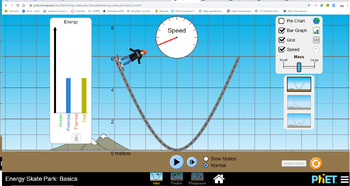Energy Skate Park PhET - Google Form Worksheet (distance learning)
- Google Drive™ folder

Description
This Energy Skate Park PhET - Google Form Worksheet is used to guide and assess students as they learn about the conservation of energy. Students will experiment with the PhET simulation and see the relationship between kinetic, potential, thermal, and total energy in a system. Students experiment with a frictionless environment as well as an environment with friction. At the end, students can play with the simulation to create their own skate park.
The Energy Skate Park PhET - Google Form Worksheet includes 12 multiple choice questions in the format of a quiz, allowing for automatic grading. The answers have already been entered into the answer key. Hassle-free grading for teachers! Just link this form to google classroom and the rest handles itself. You will be able to see all student responses (including missed answers).
This also includes a guide for using basic google form features, PDF copy of the worksheet, and PDF Answer key
__________________________________________________
The PhET interactive Skate Park simulation allows students to learn about mechanical and thermal energy in relation to the Law of Conservation of Energy. This simulation is available for free at PhET Skate Park
Learn about conservation of energy with a skater dude! Build tracks, ramps, and jumps for the skater and view the kinetic energy, potential energy, and friction as he moves. You can also take the skater to different planets or even space!




